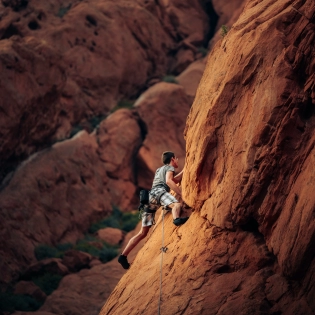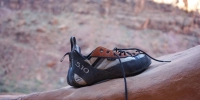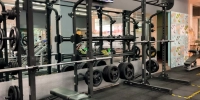How To Choose Climbing Shoes: The Definitive Guide To Types, Fit & More

Choosing the right pair of climbing shoes is one of the most critical decisions a climber can make. The right shoes not only enhance your performance on the rock or in the gym but also significantly impact your comfort and overall enjoyment. Whether you're a complete novice stepping into a climbing gym for the first time or a seasoned veteran tackling complex routes, understanding the nuances of climbing shoe design and fit is essential. This comprehensive guide will walk you through everything you need to know to find the perfect climbing shoes for your needs, helping you step up your climbing game.
- The Purpose And Benefits Of Climbing Shoes
- Understanding Climbing Shoe Anatomy And Parts
- Material Differences: Synthetic Vs. Leather Climbing Shoes
- Choosing The Right Closure System: Lace Vs. Velcro Vs. Slippers
- Types Of Climbing Shoes By Profile And Asymmetry
- 1. Neutral/Flat Climbing Shoes
- 2. Moderate Climbing Shoes
- 3. Aggressive/Highly Downturned Climbing Shoes
- How To Pick The Best Climbing Shoes: Essential Tips For The Right Fit
- 1. Try Them On (Crucial!)
- 2. Understand The Fit: Snug Vs. Painful
- 3. Consider Stretching Properties
- 4. Match Shoes To Your Intended Use And Climbing Style
- 5. Match Shoes To Your Foot Shape
- Caring For Your Climbing Shoes
- Conclusion
- FAQ: Your Common Climbing Shoe Questions Answered
- Do Beginners Need Climbing Shoes?
- What Is An Aggressive Climbing Shoe?
- Should I Get Aggressive Climbing Shoes As A Beginner?
- How Should Climbing Shoes Fit?
- Do Climbing Shoes Mold To Your Feet?
- What's The Difference Between Lace Vs Velcro Climbing Shoes?
- What Are "climbing Shoe Hot Spots"?
- How Much Stretch Can I Expect From My Climbing Shoes?
- How Often Should I Resole My Climbing Shoes?
The Purpose and Benefits of Climbing Shoes
Climbing shoes are specifically designed to improve performance, protect feet, and provide comfort during climbing. Unlike regular athletic shoes, they offer unparalleled traction, sensitivity, and precision.
Key Benefits of Properly Fitted Climbing Shoes:
-
Enhanced Grip and Friction: The specialized sticky rubber soles offer superior traction on various rock surfaces, allowing for precise foot placements and confident execution of moves. This minimizes foot movement inside the shoe, ensuring your foot becomes a seamless extension of the shoe, allowing you to effectively "feel" the rock and transfer power directly to the climbing surface.
-
Improved Precision and Footwork: A snug fit and specialized toe design enable climbers to place their feet accurately on tiny edges and smears, improving efficiency and reducing wasted energy. This precision is key to mastering technical routes.
-
Increased Confidence: When you trust your footwear to hold on tiny features, your confidence on the wall grows, allowing you to push your limits and attempt more challenging climbs.
-
Reduced Foot Fatigue: While climbing shoes are meant to be snug, a properly fitted pair will support your foot and distribute pressure effectively, reducing fatigue on longer climbs or bouldering sessions.
-
Foot Protection: The durable materials and robust construction protect your feet from abrasions and impact, especially when navigating rough rock surfaces.
-
Versatility Across Terrains: Different shoe designs are optimized for specific climbing styles and terrains, allowing you to tackle anything from slab to steep overhangs with the right tools.
Understanding Climbing Shoe Anatomy and Parts
To truly understand how to choose rock climbing shoes, it’s helpful to be familiar with their key components. Each part contributes to the shoe's overall performance, fit, and durability.
-
Upper: This is the main body of the shoe, typically made from leather or synthetic materials. It determines the shoe's breathability, stretch, and overall comfort.
-
Sole: The rubber bottom of the shoe that contacts the rock. It provides the crucial friction needed for climbing. Soles vary in thickness and stiffness, impacting sensitivity and edging power. The type of rubber used also affects grip and the lifespan of the shoes.
-
Midsole: Located between the sole and the insole, the midsole provides structural support and stiffness. A stiffer midsole offers better edging support, while a softer one provides more sensitivity for smearing.
-
Rand: A strip of rubber that wraps around the edges of the shoe, particularly around the toe and heel. The rand provides additional friction, protects the upper, and contributes to the shoe's shape and tension. The tension in the rand system is crucial for shoe performance, especially in downturned models.
-
Toe Box: The front part of the shoe where your toes reside. Its shape (asymmetrical, pointed, or rounded) greatly influences precision on small holds.
-
Heel Cup: The rear portion of the shoe designed to secure your heel. A well-fitting heel cup is vital for heel hooking and preventing slippage.
-
Closure System: This determines how the shoe is secured on your foot. Common types include laces, Velcro (hook-and-loop), and slip-on (slipper) designs.
Material Differences: Synthetic vs. Leather Climbing Shoes
The choice between synthetic and leather materials for your climbing shoes significantly impacts their fit, feel, and performance over time. Each has distinct advantages and disadvantages that influence how the shoe breaks in and performs.
Leather Climbing Shoes
Leather is a traditional material known for its ability to conform to the foot.
Pros of Leather Climbing Shoes:
-
Molds to Your Feet: Leather stretches and shapes to the unique contours of your foot over time, providing a highly personalized and comfortable fit. This is why many climbers note that leather shoes mold well to their feet, offering a truly customized feel.
-
Breathable: Leather generally offers better breathability compared to synthetic materials, which can help reduce sweat and odor buildup.
-
Durable: With proper care, leather shoes can be very durable and last a long time.
Cons of Leather Climbing Shoes:
-
Stretches Significantly: Leather shoes can stretch up to a full size, sometimes even more. This means you often need to size them down aggressively initially, which can be uncomfortable during the break-in period.
-
Longer Break-in Period: Due to their stretching properties, leather shoes typically require a longer break-in period to achieve their optimal fit and comfort.
-
Odor: While breathable, leather can sometimes absorb more odor if not properly cared for.
Synthetic Climbing Shoes
Synthetic materials are a popular alternative, often made from microfibers.
Pros of Synthetic Climbing Shoes:
-
Less Stretch: Synthetic shoes stretch very little (usually less than half a size), meaning they retain their original shape and fit more consistently over their lifespan. This predictability can be a major advantage.
-
Maintains Shape: They hold their downturn and asymmetry better than leather, making them ideal for aggressive designs.
-
Vegan Options: Many synthetic shoes are vegan-friendly, which is an important consideration for some climbers.
-
Faster Break-in: Due to minimal stretching, synthetic shoes typically have a much shorter or almost non-existent break-in period.
Cons of Synthetic Climbing Shoes:
-
Less Breathable: Synthetic materials tend to be less breathable, which can lead to hotter feet and more sweat, potentially increasing odor.
-
Can Be Stiffer: Some synthetic shoes can feel stiffer out of the box and may not offer the same "glove-like" feel as broken-in leather.
-
Doesn't Mold as Much: While consistent, they won't mold to your specific foot shape as intimately as leather.
Choosing the Right Closure System: Lace vs. Velcro vs. Slippers
The closure system of your climbing shoe affects the fit, convenience, and performance on different types of climbs. The primary options are lace-up, Velcro, and slipper designs. Understanding the pros and cons of lace vs Velcro climbing shoe systems can help you decide.
Lace-Up Climbing Shoes
Lace-ups offer the most customizable fit.
Pros of Lace-Up Shoes:
-
Precision Fit: Laces allow for micro-adjustments across the entire foot, enabling a highly customized and secure fit. This is excellent for ensuring optimal performance on small edges and varied foot shapes.
-
Molds to Foot: The adjustable nature of laces allows the shoe to conform better to your foot over time as it breaks in.
-
Versatility: Good for a wide range of climbing styles, from long trad routes to technical sport climbs, where a consistent, dialed-in fit is crucial.
-
Reduced Pressure Points: The ability to adjust tension precisely can help alleviate uncomfortable pressure points.
Cons of Lace-Up Shoes:
-
Slow to Put On/Take Off: Lacing up and unlacing takes time, which can be inconvenient for bouldering or gym sessions where you frequently remove your shoes between climbs.
-
Laces Can Get in the Way: Laces can snag on rock or be an annoyance when heel hooking, though this is a minor concern for most.
Velcro (Hook-and-Loop) Climbing Shoes
Velcro shoes are known for their convenience.
Pros of Velcro Shoes:
-
Fast and Easy On/Off: The primary advantage is quick transitions, making them ideal for bouldering, gym climbing, or multi-pitch routes where you might want to quickly remove your shoes at belays.
-
Convenience: Great for training sessions where you're constantly taking shoes on and off.
-
Good Security (for most uses): While not as precise as laces, modern Velcro systems offer very secure closure for most climbing styles. Many consider them among the best Velcro climbing shoes for gym and bouldering, providing a strong option in the climbing shoes laces vs Velcro discussion.
Cons of Velcro Shoes:
-
Less Adjustable: Velcro straps offer less precise tension adjustment compared to laces, which can sometimes lead to minor fit compromises.
-
Less Secure (for extreme edging): On extremely technical routes requiring maximum edging power, laces may offer a slightly more locked-down feel.
-
Velcro Can Wear Out: Over time, Velcro can lose its stickiness, though this is generally after significant use.
Slipper Climbing Shoes
Slippers are minimalist shoes that rely on elastic and a snug fit.
Pros of Slipper Shoes:
-
Maximum Sensitivity: With no laces or straps, slippers often feel like a second skin, offering exceptional sensitivity to the rock.
-
Easy On/Off: Extremely quick to slip on and off.
-
Ideal for Specific Techniques: Great for crack climbing, smearing, and some types of bouldering where a minimalist shoe is preferred.
Cons of Slipper Shoes:
-
Less Support: They offer less structural support than lace-up or Velcro shoes, which can be fatiguing on long routes.
-
Fit is Critical: The fit must be perfect; if too loose, they'll slip; if too tight, they'll be unbearable. There's no adjustability.
-
Not for Beginners: Generally not recommended for beginners due to the lack of support and very specific fit requirements.
Types of Climbing Shoes by Profile and Asymmetry
Climbing shoes are categorized by their shape, specifically their profile (downturn) and asymmetry. Understanding these different types of climbing shoes is crucial for matching the shoe to your climbing style and the terrain you'll encounter.
1. Neutral/Flat Climbing Shoes
-
Profile: These shoes have a relatively flat profile, similar to a street shoe, with little to no downturn in the toe.
-
Asymmetry: Typically symmetrical, meaning the toe box is centered.
-
Best For:
-
Beginners: They offer maximum comfort and are forgiving for developing footwork. When considering if beginners need climbing shoes, neutral shoes are often the recommended starting point.
-
All-Day Comfort: Excellent for long multi-pitch routes, trad climbing, and casual gym sessions where comfort over extended periods is paramount.
-
Crack Climbing: Their flat profile makes them ideal for slotting into cracks without pain.
-
Slab Climbing: Good for smearing on low-angle rock where maximum rubber contact is needed.
-
-
Characteristics: Comfortable, breathable, good for extended wear, and generally the most comfortable type for general use.
2. Moderate Climbing Shoes
-
Profile: These shoes feature a slight downturn in the toe and some asymmetry, making them a versatile middle-ground.
-
Asymmetry: Slightly asymmetrical, allowing for more power to be focused on the big toe.
-
Best For:
-
Intermediate Climbers: A great upgrade from neutral shoes for those looking to improve performance on more challenging terrain.
-
Sport Climbing: Versatile for a variety of angles and holds.
-
Bouldering: Can handle many bouldering problems without the extreme aggression.
-
All-Around Use: A good choice if you engage in various climbing disciplines, as moderate climbing shoes strike a balance between comfort and performance.
-
-
Characteristics: Balanced performance, comfortable enough for longer sessions but with improved edging and hooking capabilities.
3. Aggressive/Highly Downturned Climbing Shoes
-
Profile: These shoes have a significant, noticeable downturned toe, often resembling a "claw." This shape allows the climber to pull with their feet on steep terrain.
-
Asymmetry: Highly asymmetrical, with the toe box curving sharply towards the big toe. This focuses all power onto a single point for maximum precision.
-
What is an Aggressive Climbing Shoe? An aggressive climbing shoe is characterized by its pronounced downturned toe and asymmetrical shape. This design is specifically engineered to excel on steep, overhanging terrain and tiny holds. The downturn allows your toes to "hook" onto features, pulling your body closer to the wall, while the asymmetry directs all the force to your big toe for precise edging and toe-hooking. These are specialized tools for high-performance climbing.
-
Best For:
-
Steep Sport Climbing: Overhangs, pockets, and tiny edges.
-
Bouldering: Particularly on steep problems and those requiring intricate toe-hooking. Aggressive bouldering shoes are a staple for advanced problems.
-
Competition Climbing: Where every ounce of power and precision matters.
-
-
Characteristics:
-
Power and Precision: Unmatched for pulling on steep rock and standing on minute edges.
-
Less Comfortable: Due to their extreme shape, they are generally less comfortable for long periods and should typically be removed between climbs.
-
Specialized: Not a general-purpose shoe.
-
-
Are Aggressive Climbing Shoes for Beginners? In most cases, aggressive climbing shoes are not recommended for beginners. Here's why:
-
Discomfort: Their aggressive downturn and tight fit can be quite painful for unaccustomed feet. Beginners are still developing foot strength and technique, and this discomfort can be a deterrent.
-
Technique Development: Beginners need to focus on developing fundamental footwork, which is often better learned in a more comfortable, neutral shoe. Aggressive shoes can compensate for poor technique rather than helping to build good habits.
-
Overkill: Most beginner routes and problems do not require the specialized performance of an aggressive shoe. A neutral or moderate shoe will provide ample performance for learning.
-
Cost: Aggressive shoes tend to be more expensive, an unnecessary investment for a beginner.
So, should you get aggressive climbing shoes as a beginner? Generally, no. Start with neutral or slightly moderate shoes. As your technique progresses and you move onto steeper, more challenging climbs that explicitly demand more power from your feet, then consider a moderate or aggressive pair. The best aggressive rock climbing shoes are typically for experienced climbers tackling advanced routes.
-
How to Pick the Best Climbing Shoes: Essential Tips for the Right Fit
The fit of your climbing shoe is arguably the most important factor. A well-fitting shoe feels snug but not painful, allowing you to use your feet effectively. This section will guide you on how to pick a climbing shoe that fits perfectly, helping you choose rock climbing shoes that enhance your performance.
1. Try Them On (Crucial!)
-
Always try before you buy: Foot shapes vary wildly, and what fits one person perfectly might be agony for another.
-
Try on at the end of the day: Your feet swell throughout the day, so trying shoes on when they are slightly larger gives a more accurate fit.
-
Wear thin socks or no socks: Climbing shoes are often worn without socks, or with very thin ones, to maximize sensitivity.
-
Spend time in them: Walk around, stand on small edges (if the shop has a climbing wall or board), and feel how the shoe performs. Don't rush the process.
2. Understand the Fit: Snug vs. Painful
A good climbing shoe fit is snug, with no dead space, but it shouldn't cause excruciating pain or curling of your toes into a painful knot.
-
Toes: Your toes should be at the very end of the shoe, perhaps slightly bent or "knuckled" (especially in performance-oriented shoes), but not painfully cramped. There should be no significant air pockets above or around your toes.
-
Heel: The heel should be securely locked into the heel cup with no slippage when you flex your foot or try to pull your heel out. Heel slippage can lead to discomfort and loss of power.
-
Overall Tightness: The shoe should feel like a second skin, with no significant baggy areas.
3. Consider Stretching Properties
As discussed in the materials section:
-
Leather: Will stretch significantly (up to a full size), so size down. They will mold to your feet over time.
-
Synthetic: Will stretch very little (1/4 to 1/2 size), so buy them closer to your ideal fit. They maintain their shape well.
4. Match Shoes to Your Intended Use and Climbing Style
How to pick climbing shoes depends heavily on what you'll be climbing:
-
Bouldering & Steep Sport Climbing: Often demands more aggressive, downturned shoes for power and precision on small holds and overhangs. The focus is on short, intense efforts.
-
Trad Climbing & Multi-pitch: Comfort is paramount for long days. Neutral or moderately downturned shoes are preferred. You'll likely want something you can wear for hours.
-
Gym Climbing: Can vary. If primarily bouldering, more aggressive might be suitable. If rope climbing, a moderate shoe offers a good balance. If you're a beginner, start with a neutral shoe.
5. Match Shoes to Your Foot Shape
Feet come in many shapes (e.g., wide, narrow, high arch, low arch, Egyptian, Greek, Roman toe types). Different shoe brands and models are designed around different foot lasts (molds).
-
Last Shape: Some shoes are built on a symmetrical, straight last, while others have a highly asymmetrical, curved last.
-
Volume: Some shoes are high-volume (more room for thicker feet), others are low-volume (for narrower feet).
-
Trial and Error: Don't be afraid to try shoes from multiple brands and models. What fits your friend might not fit you.
Caring for Your Climbing Shoes
Proper care can significantly extend the life of your climbing shoes:
-
Air Them Out: Always air your shoes out after each session to prevent odor and mildew. Do not store them in a sealed bag.
-
Avoid Extreme Heat: Do not leave them in hot cars or direct sunlight, as this can degrade the rubber.
-
Clean When Needed: If they get muddy or excessively dirty, gently clean them with water and a soft brush, then air dry.
-
Resole: When the sole wears thin, especially at the toe, get them resoled by a professional cobbler specializing in climbing shoes. Resoling extends their life and is more sustainable than buying new pairs.
Conclusion
Choosing the ideal pair of climbing shoes is a personalized journey that significantly impacts your climbing progression and enjoyment. By understanding the different types of shoes, their anatomy, material properties, and closure systems, you can make an informed decision that aligns with your climbing style and goals. Remember, the perfect shoe isn't about the highest price or the most aggressive design; it's about finding a pair that fits your feet comfortably, supports your technique, and inspires confidence on the wall. Take your time, try on various options, and invest in shoes that will truly help you step up your climbing game.
FAQ: Your Common Climbing Shoe Questions Answered
Do beginners need climbing shoes?
Yes, while you can climb in athletic shoes, proper climbing shoes significantly improve grip, precision, and footwork, which are crucial for learning and progression. It's recommended that beginners start with comfortable, neutral-profile shoes.
What is an aggressive climbing shoe?
An aggressive climbing shoe is characterized by its pronounced downturned toe and often a highly asymmetrical shape. This design is optimized for maximum power and precision on steep, overhanging terrain and very small footholds, allowing climbers to "pull" with their feet more effectively.
Should I get aggressive climbing shoes as a beginner?
Generally, aggressive shoes are not recommended for beginners. Their extreme design can be uncomfortable and may hinder the development of proper footwork. Beginners typically benefit more from neutral or moderate shoes that prioritize comfort and allow for better technique learning.
How should climbing shoes fit?
Climbing shoes should fit snugly, like a second skin, with no dead space or excessive movement. Your toes should reach the end of the shoe, possibly with a slight bend, but without painful cramping. The heel should feel secure, without any slippage.
Do climbing shoes mold to your feet?
Yes, many climbing shoes, particularly those made from leather, will stretch and conform to the unique contours of your feet over time. Synthetic shoes stretch much less but will still "break in" to become more comfortable and adapt slightly to your foot shape.
What's the difference between lace vs Velcro climbing shoes?
Lace-up climbing shoes offer the most customizable and precise fit, allowing for fine-tuning of tension across the foot, but they are slower to put on and take off. Velcro climbing shoes provide quick and easy on/off convenience, making them popular for bouldering and gym climbing, though they offer less precise adjustability than laces.
What are "climbing shoe hot spots"?
Climbing shoe hot spots are areas of uncomfortable pressure, rubbing, or pain on your foot caused by an improper fit. These can occur on the knuckles of your toes, the heel, or the arch. They often indicate that the shoe is either too tight in a specific area or has a shape that doesn't match your foot well.
How much stretch can I expect from my climbing shoes?
The amount of stretch depends on the material. Leather shoes can stretch significantly, sometimes up to a full shoe size or more. Synthetic shoes, on the other hand, stretch minimally, usually less than half a size. This difference is a crucial factor when choosing your size.
How often should I resole my climbing shoes?
You should resole your climbing shoes as soon as you notice the sole wearing thin, especially at the toe. It's best to resole before you wear through the underlying rand rubber, as repairing the rand adds cost and complexity to the resoling process. The frequency will depend on how often you climb and your personal footwork technique.













